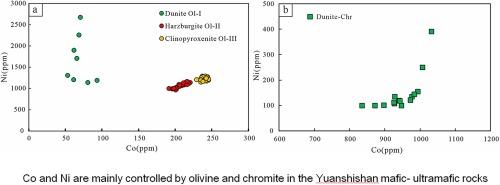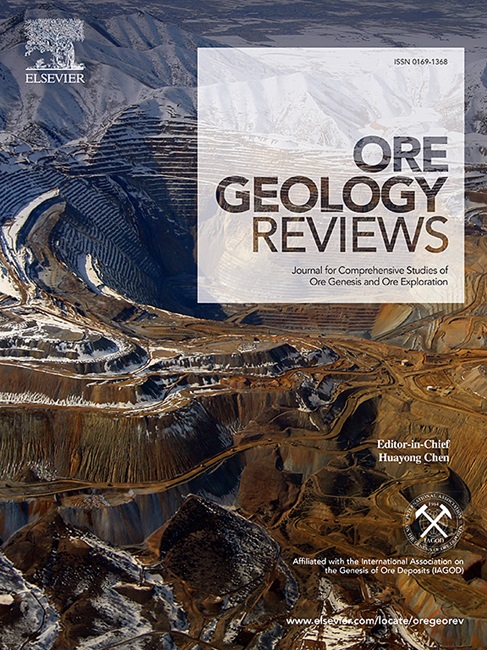中国西北部青海省元石山镍钴红土矿床橄榄石和鳞片辉石母岩的地球化学特征
IF 3.2
2区 地球科学
Q1 GEOLOGY
引用次数: 0
摘要
元石山是一个红土镍钴矿床,位于中国西北部南祁连造山带的腊子山构造带。镍钴矿化是在母岩黑云母-超基性岩风化过程中形成的。人们对这些母岩的岩石成因知之甚少。因此,我们对元石山镍钴矿床未风化的黑云母-超基性岩中的橄榄石和霞石进行了野外和岩相学研究,以及原位主要元素和痕量元素分析。结果表明,在元石山黑云母-超基性岩中,橄榄石(Ni 963-2674 ppm,Co 52.7-245 ppm)比陨辉石(Ni 155-203 ppm,Co 23.1-32.5 ppm)富含 Co 和 Ni。铬铁矿(Ni 98.8-892 ppm,Co 836-1062 ppm)的Co和Ni含量高于clinopyroxene,但Ni含量低于橄榄石,Co含量高于橄榄石。因此,橄榄石和铬铁矿是元石山母岩中两种主要的富Co和Ni矿物。通过对比元石山矿床与其他岩浆硫化物矿床的橄榄石和鳞片辉石的成分,可以发现元石山母岩的镍含量相对较低,而钴含量较高。元石山云英岩中的橄榄石具有相当高的 Fo 值(95.2-98.3)。元石山橄榄石晶粒的 Ni 含量与 Ni/Co 或 Co 含量也呈正相关,与 Fo 值的相关性不明显。Co 含量与 Ni 含量和 Fo 值呈负相关,这与地幔橄榄石的特征一致。此外,橄榄石中 Li、Sc、V 的含量均低于 10 ppm,表明岩浆来源于地幔。辉石中 Al、Si、Ti、Ca 和 Na 的含量表明原始岩浆可能是亚碱性玄武岩熔体。根据橄榄石-尖晶石温度计的计算,元石山岩浆的结晶温度为1256-1376 °C。烊辉石的铝Ⅳ:铝Ⅵ比值(0.7-6.0)和Eu/Eu*值(0.9-1.4)表明元石山黑云母-超黑云母岩是在中低压和高富氧条件下形成的。此外,霞石的地球化学判别图显示这些岩石可能是在岛弧环境下形成的。本文章由计算机程序翻译,如有差异,请以英文原文为准。

Geochemical characteristics of olivine and clinopyroxene in parental mafic–ultramafic rocks from the Yuanshishan Ni-Co laterite deposit in Qinghai Province, NW China
Yuanshishan is a Ni-Co laterite deposit that occurs in the Lajishan tectonic zone of the South Qilian orogenic belt, NW China. Ni–Co mineralization took place during the weathering of the parental mafic–ultramafic rocks. Little is known about the petrogenesis of these parent rocks. Therefore, field and petrographic investigations, together with in situ major and trace element analyses, were carried out on olivine and clinopyroxene from unweathered mafic–ultramafic rocks in the Yuanshishan Ni-Co deposit. The results show that olivine (Ni 963–2674 ppm, Co 52.7–245 ppm) is richer in Co and Ni than clinopyroxene (Ni 155–203 ppm, Co 23.1–32.5 ppm) in the Yuanshishan mafic–ultramafic rocks. The chromite (Ni 98.8–892 ppm, Co 836–1062 ppm) show higher Co and Ni than clinopyroxene, but has lower Ni but higher Co than olivine. Therefore, olivine and chromite are two main Co and Ni rich minerals in the parent rocks of Yuanshishan. A compositional comparison of olivine and clinopyroxene from the Yuanshishan deposit to those from other magmatic sulfide deposits reveals that the Yuanshishan parent magma is relatively poor in Ni and rich in Co. Olivine in the dunite of Yuanshishan has a quite high Fo value (95.2–98.3). The Yuanshishan olivine grains also show a positive correlation between Ni content and Ni/Co or Co content, and the correlation with Fo value is not obvious. The Co content shows a negative correlation with the Ni content and Fo value, which are consistent with the mantle olivine characteristics. Furthermore, the Li, Sc, V contents in olivine are lower than 10 ppm, indicating that the magma originated from the mantle. The Al, Si, Ti, Ca, and Na contents in clinopyroxene indicate that the original magma may have been subalkaline basaltic melt. Using an olivine-spinel thermometer, the Yuanshishan magma crystallization temperatures are calculated to be 1256–1376 °C. The AlⅣ:AlⅥ ratio (0.7–6.0) and Eu/Eu* value (0.9–1.4) of the clinopyroxene indicate that the Yuanshishan mafic–ultramafic rocks were formed under conditions of low to medium pressure and high oxygen fugacity. Moreover, the geochemical discriminant diagrams of clinopyroxene indicate that these rocks possibly formed in an island arc setting.
求助全文
通过发布文献求助,成功后即可免费获取论文全文。
去求助
来源期刊

Ore Geology Reviews
地学-地质学
CiteScore
6.50
自引率
27.30%
发文量
546
审稿时长
22.9 weeks
期刊介绍:
Ore Geology Reviews aims to familiarize all earth scientists with recent advances in a number of interconnected disciplines related to the study of, and search for, ore deposits. The reviews range from brief to longer contributions, but the journal preferentially publishes manuscripts that fill the niche between the commonly shorter journal articles and the comprehensive book coverages, and thus has a special appeal to many authors and readers.
 求助内容:
求助内容: 应助结果提醒方式:
应助结果提醒方式:


